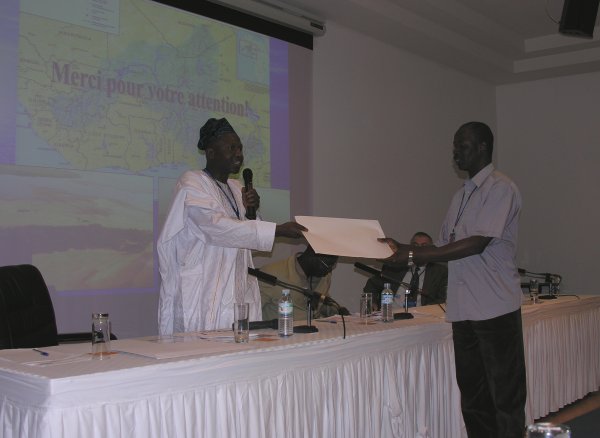Two Ramsar sites in Guinea add 800,000 hectares to the Ramsar List

Guinea names two Ramsar sites new in Gambia catchment
The Ramsar Secretariat is pleased to announce that during a side event organized by DCFAP (Directorate for Fauna Conservation and Protected Areas, Ramsar's Administrative Authority in Chad) at Ramsar's 9th Conference of the Parties, 14 November 2005, Senior Ramsar Advisor for Africa Abou Bamba presented Guinea's Namory Keita, Directeur national, Direction nationale de la Protection de la nature, with the certificates for two new Ramsar sites, bringing Guinea's total to 14 Wetlands of International Importance covering 5,587,861 hectares. Preparations for the designations of the new sites, Gambie-Koulountou (a National Park and UNESCO Biosphere Reserve) and Gambie-Oundou-Liti in the northwest of the country, were greatly assisted by WWF's Global Freshwater Programme.
Ramsar's Assistant Advisor for Africa, Lucia Scodanibbio, has prepared brief descriptions of the two sites based on the Ramsar Information Sheets submitted with their nomination.

Senior Ramsar Advisor for Africa Abou Bamba (left) presents Guinea's Namory Keita, Directeur national, Direction nationale de la Protection de la nature Guinea, with certificates for two new Ramsar sites (Photo: Denis Landenbergue, WWF)
Gambie-Koulountou. 14/11/05; Boké; 281,400 ha; 12°01'N 013°34'E. National Park, UNESCO Biosphere Reserve. A semi-arid region at the border with Senegal, comprising the floodplain of the Koulountou River, the Gambia River's main tributary, and a number of smaller, often temporary watercourses and ponds. These water bodies support numerous species, including 80 species of mammals, 330 of birds, as well as reptiles and amphibians, which find an important refuge in the site especially during the dry season. The vegetation, varying through savanna, forest, woodland, and aquatic species, plays an important role in preventing erosion and siltation of the wetlands, while humus deposition increases the floodplain's fertility, allowing rice cultivation to take place. Fishing and animal raising are also significant activities, while non-timber forest products are collected for several uses, with Borassus aethiopum, raffia and bamboo being the most exploited species. In the core area of the Badiar Biosphere Reserve, no activity other than conservation is allowed to take place, but in the periphery, a co-management system is in place to allow the varied communities to make use of the site. Bush fires, illegal fishing, pesticide use, and slash and burn agriculture constitute some of the main threats to the site. Ramsar site no. 1578.
Gambie-Oundou-Liti. 14/11/05; Labé, 527,400 ha; 11°33'N 012°18'W. Nature Reserve. A mountainous site in the Fouta massif that plays an important hydrologic role as the origin of numerous water courses which flow into surrounding countries and are regulated by three protected forests. Floodplains, savannas, gallery and mountain forests are important habitats, reproduction, resting and feeding sites for some threatened species such as lions, chimps and wild dogs, and for many more mammal, raptor and waterbird species for which there is still little information available. Agriculture (subsistence and fruit trees) and animal raising are the main land uses, while apiculture and fishing are less developed. Water is considered a public good with water courses and sources managed communally, based on the Water Code. There is a high tourist potential in the area that remains to be exploited, with several interesting cultural and natural attractions, including underground mosques, mysterious tombs, smoky caves, giant bees, waterfalls and warrior "tatas" or fortified houses. One of the main threats to the site, as well as to downstream wetlands, is the projected Sambagallo dam, which will flood part of the Kabéla forest. Ramsar site no. 1579.